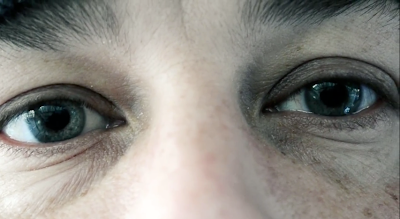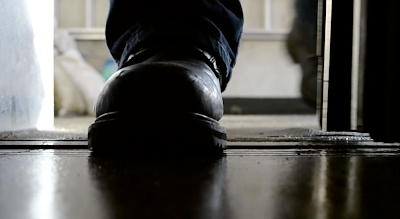In order to gain effective feedback for our thriller opening, Transit, I decided to give questionnaires to people after they had watched the film. This meant that I had real feedback and I was able to constantly refer back to it. Our audience demographic is 16 - 18 year old British males from white and ethnic minority communities. This is because the main character is from an ethnic minority and the antagonist is a white working class male. Ethnic minority youths, particularly since the 2011 London riots, have been negatively represented within the media; our film challenges this stereotype. Therefore our film will attract this stereotype. I decided it would be best to ask both females and males in this age group to watch the film and then answer the questions afterwards because it would give a fair representation of the audience that found the film most appealing and why. This became extremely useful because it enabled me to know exactly what the demographic identified with. It was more important to gather feedback from the males because they were the target audience; thus their response to what they identified with would be vital. I chose to gather questionnaires from 2 boys and 1 girl in between the ages of 16 -18, these are scanned in below.
I purposely sought after participants who fully ranged between the target ages of 16 - 18, with one participant being 16, one being 17 and the other being 18. Therefore I was able to collect feedback from the complete target demographic, not just people my own age.
When looking at the answers given it was mostly positive, with only a few negative comments; showing that Transit was overall well received by the audience. The film was successful in telling the story as the audience rated this element 4 or higher; therefore they were able to identify with the film through the narrative. Most people probably found it reasonably easy to understand because it was a linear narrative (meaning events go from the start to the middle to the end) instead of a more complicated narrative structure (such as a circular narrative) that included techniques like flashback. We decided to keep the narrative as simple as possible given we only had 2 minutes to effectively engage the audience; this clearly worked as the plot was understood without any great difficulty.
 One aspect that was rated highly was the camerawork and editing of the overall film. Each participant who answered the questionnaire gave this section a 5; showing that the way that the film was shot made it more attractive and intriguing. When planning to shoot we decided to use our own DSLR's because they allowed us to shoot in 1080p HD, this gave a clearer/crisp picture which may have been why the audience found this element so appealing. The participants who answered the survey were surprised by the quality of the footage, meaning that they were more likely to carry on watching because it demonstrated that we had put a lot of effort into various camera angles and shot types. This was emphasised even further when I asked each participant to highlight the best aspect of the film and each time they circled camera work and added comments such as "good range of shots" and "really nicely shot, great lighting too"; clearly showing that my camera operating skills played a part in attracting the audience.
One aspect that was rated highly was the camerawork and editing of the overall film. Each participant who answered the questionnaire gave this section a 5; showing that the way that the film was shot made it more attractive and intriguing. When planning to shoot we decided to use our own DSLR's because they allowed us to shoot in 1080p HD, this gave a clearer/crisp picture which may have been why the audience found this element so appealing. The participants who answered the survey were surprised by the quality of the footage, meaning that they were more likely to carry on watching because it demonstrated that we had put a lot of effort into various camera angles and shot types. This was emphasised even further when I asked each participant to highlight the best aspect of the film and each time they circled camera work and added comments such as "good range of shots" and "really nicely shot, great lighting too"; clearly showing that my camera operating skills played a part in attracting the audience.Another successful element of the mise en scene that the audience felt was engaging was the soundtrack that was used alongside the action. I made sure to look at the music that has been used in other thrillers that are similar to Transit, such as "Kidulthood" or "Drive" and then found our soundtrack. This meant the audience were attracted by the soundtrack as it was similar to other generic soundtracks they had heard from other thrillers. It was noted by the participants that the soundtrack also helped to set the pace of the action and was also effective in creating ramping tension towards the end of the sequence, particularly the scene in which Bill's boot stops the door from closing.
Soundtrack for getaway scene in "Drive". Notice how it helps to build tension progressively throughout the scene.
When it came to addressing the audience we ended up doing it in a detached style because the audience may have found it difficult to identify with the character of John due to his callous or unfeeling response to Hanna's dead body in the lift. That left us having to address/attract the audience through the use of camera angles, style, colour grade and cliffhanger. The audience will have been attracted through the character of Bill however, this is because he is rarely seen and is shown to be a very ambiguous character. This provides an enigma of mystery and menace which will have helped to attract the audience because there is still more to be revealed about Bill. Bill provides unanswered questions in the opening, causing the audience to speculate and prevent them from loosing interest.
 |
| Hanna in Transit, displaying a Lisbeth Salander like costume. |
Despite Hanna being killed rather early on in to the film, the female who answered the questionnaire said that she would like to see the rest of the film regardless. This was good to know because it meant that we had managed to make the film attractive to the female audience through other aspects within the mise en scene, particularly the wide "range of shot types". Another factor that may have been appealing to a female audience was the attraction to the young male character, John, because of his appearance.
Notice how the colour grade used in "Emulsion" makes the film more appealing aesthetically and it adds a dark mood/gritty feeling; thus it is clearly making use of the generic conventions. If I had also applied a similar colour grade as seen in the above picture then the audience may have felt more attracted to the film because it would posses more of the generic conventions that they might have perhaps expected.
 One of the most important elements of the film was the cliffhanger because it acted as a hook for the rest of the film. The scene in which Bill's boot stops the elevator door from closing acted as the hook for our film. We used this cliffhanger to ensure that the audience wouldn't lose interest in the action and would want to continue to watch the rest of the film. This also helped to provide many unanswered questions and a burning desire to know where the plot goes next.
One of the most important elements of the film was the cliffhanger because it acted as a hook for the rest of the film. The scene in which Bill's boot stops the elevator door from closing acted as the hook for our film. We used this cliffhanger to ensure that the audience wouldn't lose interest in the action and would want to continue to watch the rest of the film. This also helped to provide many unanswered questions and a burning desire to know where the plot goes next.Overall the participants rated Transit 9 out of 10, clearly showing that the film was able to attract the demographic that we had originally targeted through the use of particular generic conventions such as location, camera angles/shot types and character. It was also pleasant to find out that the female audience were also interested in the film and possibly wanted to see more; most probably due to aspects of the mise en scene such as lighting and sound.





A thorough response. To tighten up your answer:
ReplyDelete1) You say...
....our target demogrpahic is black and white males ...
Note spelling mistake of demographic and "black and white males" is clumsy.
Instead say something like.... our audience demographic is 16-18 year British males from white and ethnic minority communities. This is because the main character is from an ethnic minority and the villains are white working class males. Ethnic minority youths particularly since the London riots in 2011 have been negatively represented in the press; our film challenges this stereotype. Thus our film will attract this social group....
Well done Hamish a proficient response.